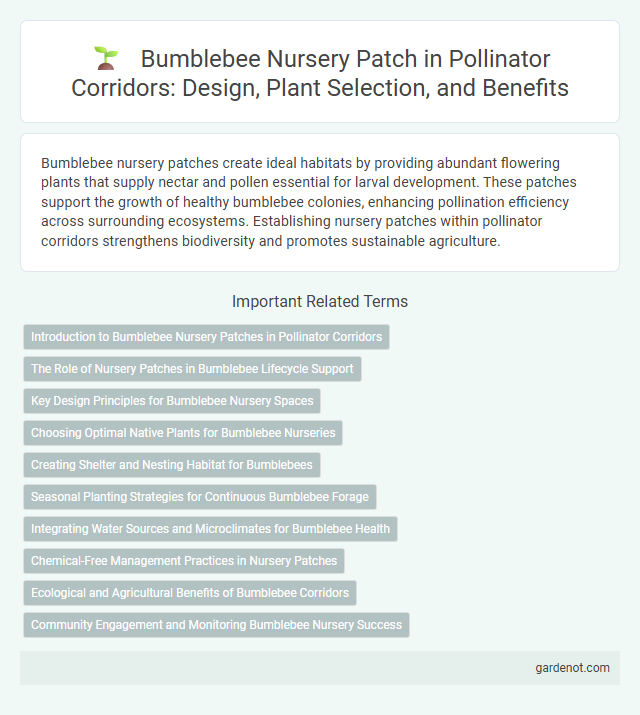Bumblebee nursery patches create ideal habitats by providing abundant flowering plants that supply nectar and pollen essential for larval development. These patches support the growth of healthy bumblebee colonies, enhancing pollination efficiency across surrounding ecosystems. Establishing nursery patches within pollinator corridors strengthens biodiversity and promotes sustainable agriculture.
Introduction to Bumblebee Nursery Patches in Pollinator Corridors
Bumblebee nursery patches within pollinator corridors provide essential habitats for queen bumblebees to establish colonies and raise offspring. These patches consist of diverse flowering plants that offer abundant nectar and pollen sources from early spring through late summer, supporting bumblebee population growth. Creating and maintaining nursery patches enhances pollination services, biodiversity, and ecosystem resilience in agricultural and urban landscapes.
The Role of Nursery Patches in Bumblebee Lifecycle Support
Bumblebee nursery patches provide essential habitats where queen bumblebees establish colonies and rear their first generation of workers, ensuring colony survival and growth. These patches offer abundant and diverse floral resources with continuous blooming periods that supply vital pollen and nectar for developing larvae. By maintaining nursery patches within pollinator corridors, conservation efforts enhance bumblebee reproductive success and contribute to ecosystem pollination stability.
Key Design Principles for Bumblebee Nursery Spaces
Key design principles for bumblebee nursery patches include selecting diverse native flowering plants that provide continuous bloom from early spring to late summer, ensuring a reliable nectar and pollen source. Soil conditions should be well-drained with areas of bare or sparsely vegetated ground to facilitate nesting sites, while avoiding pesticides and maintaining connectivity with other pollinator habitats enhances colony survival and genetic diversity. Incorporating structural elements such as tussock grasses or compost heaps offers shelter and overwintering sites essential for bumblebee lifecycle completion.
Choosing Optimal Native Plants for Bumblebee Nurseries
Selecting optimal native plants for bumblebee nursery patches enhances habitat quality and supports colony growth by providing essential nectar and pollen sources. Native wildflowers such as clover (Trifolium spp.), goldenrod (Solidago spp.), and lupine (Lupinus spp.) offer diverse flowering periods, ensuring continuous food supply throughout the breeding season. Incorporating plants with varied bloom times and flower structures maximizes resource availability and supports bumblebee species diversity within pollinator corridors.
Creating Shelter and Nesting Habitat for Bumblebees
Bumblebee nursery patches provide essential shelter and nesting habitats, supporting colony growth and reproduction. Dense vegetation and undisturbed soil layers offer ideal conditions for bumblebee queens to establish nests and raise larvae. Incorporating native flowering plants within these patches ensures a continuous food supply, enhancing nursery success and pollinator health.
Seasonal Planting Strategies for Continuous Bumblebee Forage
Implementing seasonal planting strategies in bumblebee nursery patches ensures continuous forage availability by selecting a diverse array of native flowering plants that bloom sequentially from early spring to late autumn. Incorporate early-flowering species such as willow and crocus, mid-season bloomers like clover and foxglove, and late-flowering plants including goldenrod and ivy to support bumblebee nutrition throughout their lifecycle. This staggered floral provision enhances bumblebee colony health, promotes pollination efficiency, and sustains local biodiversity within pollinator corridors.
Integrating Water Sources and Microclimates for Bumblebee Health
Incorporating water sources such as shallow puddles or dew-catching surfaces within a bumblebee nursery patch boosts hydration and foraging efficiency. Designing microclimates through strategic planting of diverse native flora and shaded areas creates temperature and humidity levels optimal for bumblebee brood development. Enhanced habitat complexity supports bumblebee health by regulating stress, improving reproductive success, and fostering robust pollinator corridors.
Chemical-Free Management Practices in Nursery Patches
Chemical-free management practices in bumblebee nursery patches involve avoiding synthetic pesticides and herbicides to protect pollinator health and enhance biodiversity. Employing organic mulches, companion planting, and natural pest predators supports plant growth while minimizing harmful chemical exposure. These methods create a safe habitat that encourages bumblebee reproduction and foraging activity, promoting a resilient pollinator corridor.
Ecological and Agricultural Benefits of Bumblebee Corridors
Bumblebee nursery patches within pollinator corridors significantly enhance local biodiversity by providing essential habitats for queen rearing and early brood development. These patches improve pollination efficiency in adjacent agricultural lands, leading to increased crop yields and better-quality produce. Establishing bumblebee corridors supports ecological resilience, promoting sustainable agriculture and ecosystem health through natural pollinator activity.
Community Engagement and Monitoring Bumblebee Nursery Success
Community engagement in a Bumblebee nursery patch involves local residents and schools participating in habitat creation and maintenance, fostering awareness of pollinator conservation. Monitoring Bumblebee nursery success includes tracking nest occupancy rates, species diversity, and foraging activity through regular surveys and citizen science programs. Data collected supports adaptive management strategies to enhance habitat quality and promote sustainable pollinator populations.
Bumblebee nursery patch Infographic

 gardenot.com
gardenot.com